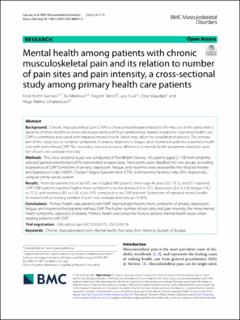| dc.description.abstract | Background: Chronic musculoskeletal pain (CMP) is characterised by pain related to the muscles or the joints with a duration of three months or more and is associated with high symptomatic burden in patients in primary health care. CMP is commonly associated with impaired mental health, which may afect the rehabilitation process. The primary aim of this study was to compare symptoms of anxiety, depression, fatigue, and insomnia in patients in primary health care with and without CMP. The secondary aim was to assess diference in mental health symptoms related to number of pain sites and pain intensity.
Methods: This cross-sectional study was conducted in Trondheim, Norway. All patients aged 21–58 from randomly selected general practitioners (GPs) were invited to participate. Participants were classifed into two groups according to presence of CMP. Symptoms of anxiety, depression, fatigue, and insomnia were assessed by the Hospital Anxiety and Depression Scale (HADS), Chalder Fatigue Questionnaire (CFQ), and Insomnia Severity Index (ISI), respectively, using an online survey system.
Results: From the patient lists of six GPs, we included 969 patients. Mean age 46 years (SD: 10.1), and 517 reported CMP. CMP patients reported higher mean symptom score for anxiety (5.4 vs 3.7), depression (3.4 vs 2.0), fatigue (14.2 vs 11.2), and insomnia (8.1 vs 4.4), all p<0.01 compared to no-CMP patients. Symptoms of impaired mental health increased with increasing number of pain sites and pain intensity (p<0.001).
Conclusions: Primary health care patients with CMP reported signifcantly more symptoms of anxiety, depression, fatigue, and insomnia than patients without CMP. The higher number of pain sites and pain intensity, the more mental health symptoms, especially of anxiety. Primary health care personnel have to address mental health issues when treating patients with CMP. | en_US |

